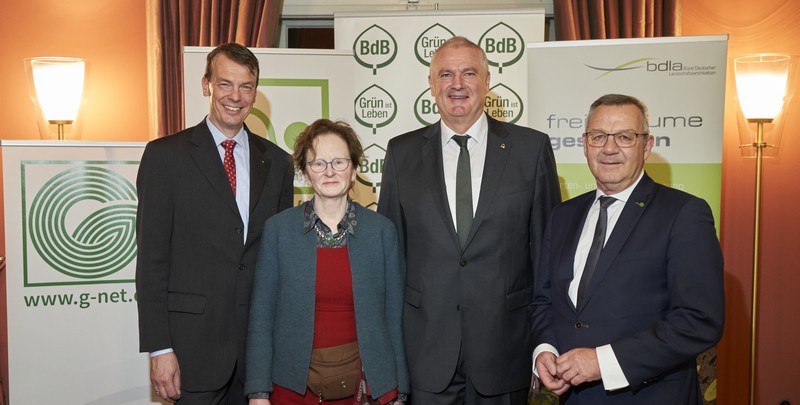Third Parliamentary Evening of the four green industry associations on 10 March 2020 in Berlin
"Municipalities in the face of climate change: What does the green infrastructure need?" - this was the question addressed at the third joint parliamentary evening of the Association of German Nurseries (BdB) e.V., the Federal Association for Garden, Landscape and Sports Ground Construction (BGL) and the Central Association for Horticulture (Zentralverband Gartenbau e.V.). (BGL), the Federation of German Landscape Architects (bdla) and the Central Horticultural Association (Zentralverband Gartenbau e.V.). (ZVG) . On Tuesday, 10 March 2020, the four industry associations invited under the patronage of the Chairman of the Committee on Food and Agriculture, Mr. Alois Gerig MdB in the German Parliamentary Society for a joint exchange.
22 members of the Bundestag and two state secretaries accepted the invitation to discuss climate change and its effects in cities together. In his introduction, BdB President Helmut Selders outlined the current situation: The hot and dry summers of the last years have shown the great challenges our cities and municipalities are facing: The streets and squares are heating up, people are groaning under the heat. People seek out the green oases and the riverbanks. So green and blue infrastructure is increasingly important.

BGL President Lutze von Wurmb commented: "Real climate protection policy is only half as valuable without natural greenery. That is why it is all the more important that designed greenery in cities and municipalities is realised in good and effective quality. There is no alternative to climate-friendly urban development that focuses on more living green. For this reason, in addition to urban development funding, we need a comprehensive federal investment program for green and blue infrastructure that also takes into account funds for the professional maintenance of green spaces."
Irene Burkhardt, bdla vice president, pointed out that a large part of climate adaptation measures can be assigned to green infrastructure and is thus mostly the original planning subject of landscape architects. Qualified green and open space development is always also a contribution against heat stress; the water-sensitive city combines functional open space structures with ecological and design qualities. The increasing concretisation from the landscape plan to the planting of the urban tree or the opening of the watercourse are part of everyday planning. The task is not new, but it has become all the more compelling.
ZVG President Jürgen Mertz pointed to the need for action on the part of local authorities and political decision-makers. The goods flow analysis for flowers, ornamental plants and woody plants published in January shows that the public sector is spending significantly less than previously assumed. In view of the challenges and the great importance of urban greenery, non-private consumption has a special role to play.
Rüdiger Dittmar, Head of the Office for Urban Greenery and Waters of the City of Leipzig, presented the situation of the blue and green infrastructure critically from the point of view of the municipalities with his impulse.
The subsequent constructive exchange with the representatives from politics and ministries showed once again how important the know-how of the green sector is for dealing with the challenges of climate change. "Green for town and country" is a forward-looking model that there is no way around.
- Latitude: 0
- Longitude: 0


